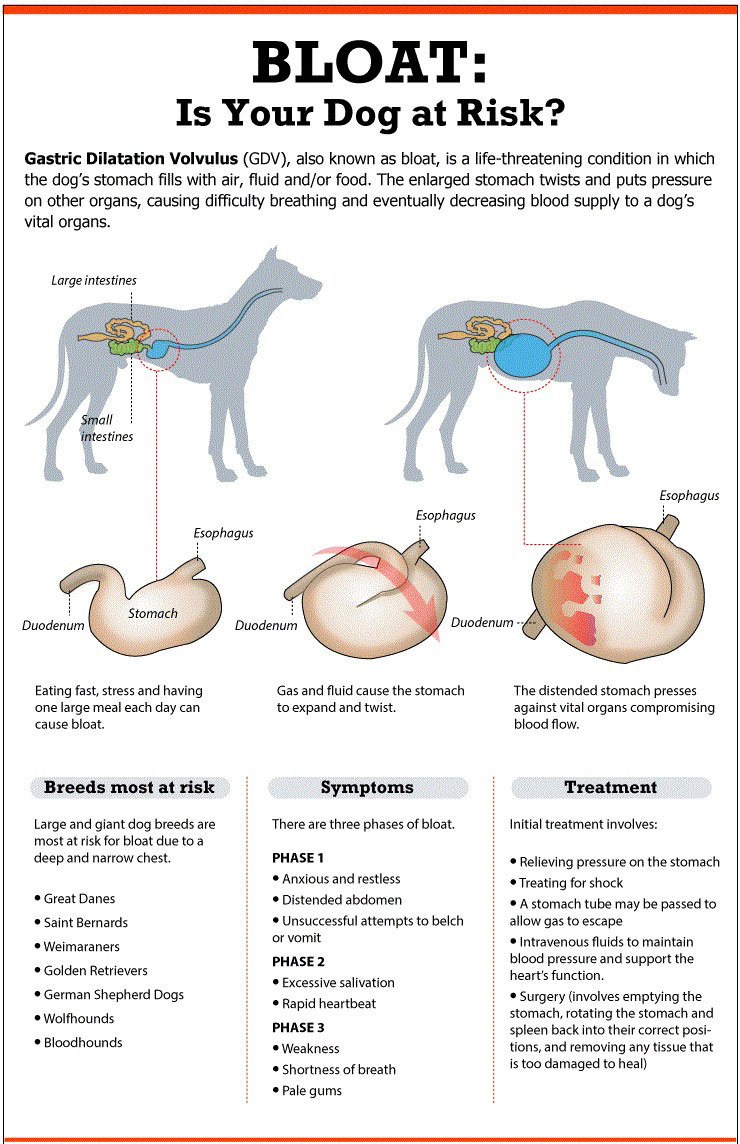Did you know that standard poodles are one of the dog breeds most prone to bloat? This alarming condition, also known as gastric dilatation-volvulus (GDV), can quickly become life-threatening for these elegant and intelligent dogs. Bloat occurs when the stomach fills with air and twists, cutting off blood flow and trapping gas inside the abdomen. It is important for poodle owners to be aware of this risk and take preventive measures to keep their beloved pets safe.
Standard poodles have a unique anatomy that contributes to their susceptibility to bloat. Their deep chests and narrow waists make them more prone to gastric torsion, where the stomach rotates on its axis. This rotation can lead to a dangerous twisting of the blood vessels, causing tissue death and organ damage. According to research, standard poodles have a 25% higher risk of developing bloat compared to other breeds. To reduce the risk, owners can consider feeding their poodles smaller, more frequent meals, avoiding strenuous exercise before and after mealtime, and using slow-feed bowls to promote slower eating.
Yes, standard poodles are prone to bloat, also known as gastric dilatation volvulus (GDV). GDV is a serious medical condition that can be life-threatening for dogs. It occurs when the stomach fills with gas and twists on itself. Standard poodles, along with other deep-chested breeds, are more susceptible to this condition. To minimize the risk, it’s important to feed them smaller meals throughout the day, avoid vigorous exercise right after meals, and consult with a veterinarian about preventive measures.

Understanding Bloat in Standard Poodles
Standard poodles are a popular breed known for their intelligence, elegance, and friendly nature. However, one concern that many poodle owners have is whether or not their furry companions are prone to developing bloat, a serious and potentially life-threatening condition. In this article, we will explore the topic of bloat in standard poodles and provide comprehensive information to help you understand the risks and preventative measures associated with this condition.
Before delving into the specifics of bloat in standard poodles, it’s important to have a clear understanding of what bloat is. Bloat, also known as gastric dilatation-volvulus (GDV), is a condition that primarily affects deep-chested breeds like standard poodles. It occurs when the stomach fills with gas, causing it to expand and twist. This can lead to severe health complications as the blood supply to the stomach and other nearby organs is compromised.
Bloat is considered to be a medical emergency and requires immediate veterinary intervention. Without prompt treatment, bloat can result in tissue death, shock, and even death of the dog. It is important for poodle owners to be aware of the risk factors associated with bloat and take preventive measures to minimize the chances of their dogs developing this condition.
Risk Factors for Bloat in Standard Poodles
While any dog can potentially develop bloat, certain factors increase the risk, particularly in deep-chested breeds like standard poodles. These risk factors include:
- Age: Older dogs, typically over the age of seven, are more susceptible to bloat.
- Sex: Male dogs are at a higher risk of developing bloat compared to females.
- Genetics: There is evidence to suggest that there may be a genetic component to bloat, making certain bloodlines more prone to the condition.
- Diet: Feeding large meals or one large meal per day, consuming dry kibble exclusively, and eating rapidly can increase the risk of bloat.
- Stress: Stressful situations, such as changes in routine or environment, can trigger bloat.
- Exercise: Exercising immediately before or after meals can increase the likelihood of bloat.
It’s important to note that while these factors may increase the likelihood of bloat in standard poodles, it does not guarantee that a dog will develop the condition. Each dog is unique, and the presence of risk factors should be taken into consideration when implementing preventive measures.
Preventive Measures for Bloat
As a responsible poodle owner, there are several preventive measures you can take to reduce the risk of bloat in your standard poodle. These include:
- Feeding smaller, more frequent meals: Instead of feeding one large meal, divide your dog’s daily food intake into smaller, portion-controlled meals.
- Using slow-feeders or puzzle toys: Slowing down your poodle’s eating habits can help prevent the ingestion of large amounts of air, reducing the chances of bloat.
- Avoiding exercise before and after meals: Allow a gap of at least one hour between feeding and exercise to allow for proper digestion.
- Opting for elevated feeders: Elevating your poodle’s food and water bowls can help reduce the amount of air they swallow while eating or drinking.
- Avoiding stressful situations: Minimize your dog’s exposure to stressful situations and provide a calm and secure environment.
While these preventive measures can help reduce the risk of bloat in standard poodles, they are not foolproof. It’s important to closely monitor your dog’s behavior and consult with your veterinarian if you notice any signs or symptoms of bloat.
Recognizing the Symptoms of Bloat
Recognizing the symptoms of bloat is crucial in ensuring prompt medical attention for your standard poodle. Some common signs to watch out for include:
- Distended abdomen: The stomach may appear visibly swollen and firm to the touch.
- Unsuccessful attempts to vomit: Your dog may appear to be retching or attempting to vomit, but nothing or only small amounts are expelled.
- Restlessness and pacing: Increased agitation and an inability to get comfortable are common signs of bloat.
- Excessive drooling: Excessive salivation can be a sign of discomfort or pain.
- Rapid breathing and panting: Bloat can cause difficulty in breathing, leading to rapid and shallow breaths.
- Weakness and collapse: As the condition progresses, your dog may exhibit weakness or collapse.
If you notice any of these symptoms, it is crucial to seek immediate veterinary assistance. Remember, bloat is a serious condition that requires prompt medical intervention to give your standard poodle the best chance for a successful recovery.
Conclusion
While standard poodles are not inherently prone to developing bloat, there are certain risk factors that can increase their susceptibility. By being aware of these factors and implementing preventive measures, you can help reduce the chances of your poodle developing bloat. It’s important to stay vigilant and seek immediate veterinary care if you suspect your dog may have bloat. Remember, early intervention is key in ensuring the best outcome for your beloved furry companion.
Key Takeaways: Are Standard Poodles Prone to Bloat?
1. Standard poodles have a higher risk of developing bloat compared to other dog breeds.
2. Bloat is a potentially life-threatening condition that affects a dog’s stomach.
3. The cause of bloat is not fully understood, but factors like genetics, diet, and stress may contribute to its development.
4. Symptoms of bloat include a bloated abdomen, restlessness, difficulty breathing, and excessive drooling.
5. It is important to minimize the risk of bloat by feeding smaller, frequent meals, avoiding exercise before and after meals, and monitoring for signs of discomfort or distress in your standard poodle.
Frequently Asked Questions
Poodles are one of the most popular and intelligent dog breeds. As a dog owner, it’s important to be aware of any potential health conditions that may affect your furry friend. One common concern among poodle owners is the risk of bloat, also known as gastric dilatation-volvulus (GDV). In this section, we will answer some frequently asked questions about whether standard poodles are prone to bloat.
1. Can standard poodles develop bloat?
Yes, standard poodles can develop bloat. While any dog breed can be affected by bloat, deep-chested breeds like poodles are more susceptible. Bloat occurs when the stomach fills with gas, liquids, or food, and then twists, cutting off blood flow to the stomach and other organs. It is a life-threatening condition that requires immediate veterinary intervention.
The exact cause of bloat is unknown, but it is thought to be a combination of genetic and environmental factors. Factors that may increase the risk of bloat in standard poodles include eating one large meal per day, eating too quickly, vigorous exercise after eating, and stress. It’s important to familiarize yourself with the signs and symptoms of bloat, such as a distended abdomen, unproductive vomiting or retching, restlessness, and difficulty breathing, so you can seek prompt medical attention if necessary.
2. How can I prevent bloat in my standard poodle?
While it’s not possible to completely eliminate the risk of bloat, there are steps you can take to help prevent it in your standard poodle. Feeding multiple smaller meals throughout the day instead of one large meal can help reduce the likelihood of bloat. Using slow feeder bowls or puzzle toys that encourage your poodle to eat more slowly can also be beneficial.
Avoiding vigorous exercise immediately after eating and minimizing stress in your dog’s environment are also important. If you’re considering a surgical procedure for your standard poodle, such as spaying or neutering, talk to your veterinarian about the potential benefits of gastropexy, a surgical procedure that can help reduce the risk of bloat in certain cases.
3. Are there any other health conditions common in standard poodles?
While bloat is a significant concern for standard poodles, there are also other health conditions that they may be prone to. These include hip dysplasia, progressive retinal atrophy (PRA), Addison’s disease, and hypothyroidism. Regular veterinary check-ups, a balanced diet, appropriate exercise, and genetic testing can help identify and manage these potential health issues.
Being aware of the common health conditions in standard poodles and taking preventive measures can help ensure the well-being of your beloved pet.
4. Can bloat be treated in standard poodles?
Bloat is a veterinary emergency and should be treated as such. If you suspect your standard poodle is experiencing bloat, it’s crucial to seek immediate veterinary care. Treatment often involves decompressing the stomach, correcting the twisting if present, and stabilizing the dog’s condition with intravenous fluids and medications.
In severe cases, emergency surgery may be required to address any damage to the stomach and other organs. The prognosis for bloat depends on how quickly it is diagnosed and treated. Prompt action increases the chances of a successful outcome for your standard poodle.
5. Should I be concerned about bloat if I’m considering getting a standard poodle?
If you’re considering getting a standard poodle as a pet, it’s important to be aware of the potential risk of bloat. While the risk exists, it shouldn’t deter you from getting a poodle if you’re otherwise prepared to provide appropriate care and attention. By following preventive measures, such as feeding smaller meals, incorporating slow feeding methods, and avoiding strenuous exercise after eating, you can help reduce the likelihood of bloat in your standard poodle.
Additionally, choosing a reputable breeder who conducts health testing on their breeding dogs can help minimize the risk of genetic predisposition to bloat and other health conditions. Regular veterinary check-ups and open communication with your veterinarian will also play a vital role in ensuring the overall health and well-being of your standard poodle.

Standard poodles have a moderate risk of developing bloat, a potentially life-threatening condition.
Owners should be aware of the signs and take preventive measures such as feeding small, frequent meals and avoiding exercise after eating.
